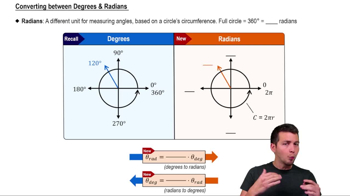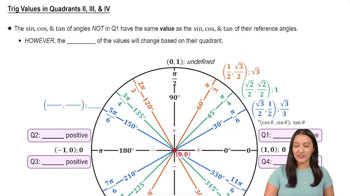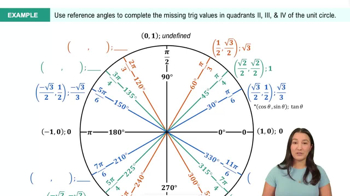Table of contents
- 0. Functions7h 52m
- Introduction to Functions16m
- Piecewise Functions10m
- Properties of Functions9m
- Common Functions1h 8m
- Transformations5m
- Combining Functions27m
- Exponent rules32m
- Exponential Functions28m
- Logarithmic Functions24m
- Properties of Logarithms34m
- Exponential & Logarithmic Equations35m
- Introduction to Trigonometric Functions38m
- Graphs of Trigonometric Functions44m
- Trigonometric Identities47m
- Inverse Trigonometric Functions48m
- 1. Limits and Continuity2h 2m
- 2. Intro to Derivatives1h 33m
- 3. Techniques of Differentiation3h 18m
- 4. Applications of Derivatives2h 38m
- 5. Graphical Applications of Derivatives6h 2m
- 6. Derivatives of Inverse, Exponential, & Logarithmic Functions2h 37m
- 7. Antiderivatives & Indefinite Integrals1h 26m
- 8. Definite Integrals4h 44m
- 9. Graphical Applications of Integrals2h 27m
- 10. Physics Applications of Integrals 2h 22m
0. Functions
Introduction to Trigonometric Functions
Problem 69
Textbook Question
Two wires stretch from the top T of a vertical pole to points B and C on the ground, where C is 10 m closer to the base of the pole than is B. If wire BT makes an angle of 35° with the horizontal and wire CT makes an angle of 50° with the horizontal, how high is the pole?
 Verified step by step guidance
Verified step by step guidance1
Identify the right triangles formed by the wires and the pole. Let the height of the pole be h, the distance from the base of the pole to point B be x, and the distance from the base of the pole to point C be x - 10 m.
Use trigonometry to express the height of the pole in terms of x. For triangle T-B, use the tangent function: \( \tan(35^\circ) = \frac{h}{x} \). This gives the equation: \( h = x \cdot \tan(35^\circ) \).
Similarly, for triangle T-C, use the tangent function: \( \tan(50^\circ) = \frac{h}{x - 10} \). This gives the equation: \( h = (x - 10) \cdot \tan(50^\circ) \).
Set the two expressions for h equal to each other: \( x \cdot \tan(35^\circ) = (x - 10) \cdot \tan(50^\circ) \).
Solve the equation for x, and then substitute back into either expression for h to find the height of the pole.
 Verified video answer for a similar problem:
Verified video answer for a similar problem:This video solution was recommended by our tutors as helpful for the problem above
Video duration:
5mPlay a video:
Was this helpful?
Key Concepts
Here are the essential concepts you must grasp in order to answer the question correctly.
Trigonometric Ratios
Trigonometric ratios relate the angles and sides of a right triangle. In this problem, the sine, cosine, and tangent functions will be used to find the height of the pole based on the angles formed by the wires with the horizontal. For instance, the tangent of an angle in a right triangle is the ratio of the opposite side to the adjacent side, which is crucial for determining the height of the pole.
Recommended video:
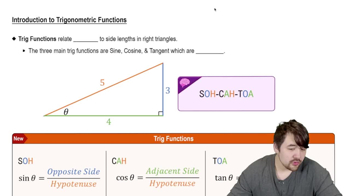
Introduction to Trigonometric Functions
Right Triangle Properties
The problem involves right triangles formed by the vertical pole and the wires. Each wire creates a right triangle with the pole as one side and the horizontal distance to points B and C as the other side. Understanding the properties of right triangles, including the Pythagorean theorem, is essential for calculating the height of the pole based on the lengths of the sides and the angles given.
Recommended video:

Properties of Functions
Angle of Elevation
The angle of elevation is the angle formed between the horizontal line and the line of sight to an object above the horizontal. In this scenario, the angles of elevation from points B and C to the top of the pole are given, which allows us to set up equations using trigonometric functions to find the height of the pole. Recognizing how these angles relate to the height and distances involved is key to solving the problem.
Recommended video:
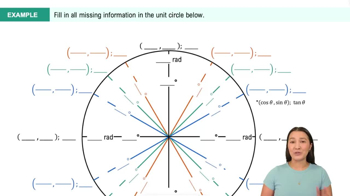
Trig Values in Quadrants II, III, & IV Example 2

 5:4m
5:4mWatch next
Master Converting between Degrees & Radians with a bite sized video explanation from Patrick Ford
Start learning
